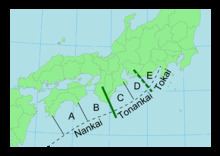Date ~ 100–150 years | Magnitude at least 8 ML | |
 | ||
The Tōkai earthquakes are major earthquakes that have occurred regularly with a return period of 100 to 150 years in the Tōkai region of Japan. The Tōkai segment has been struck by earthquakes in 1498, 1605, 1707 and 1854. Given the historic regularity of these earthquakes, Kiyoo Mogi in 1969 pointed out that another great shallow earthquake was possible in the "near future" (i.e., in the next few decades).
Contents
Given the magnitude of the last two earthquakes, the next is expected to have at least a moment magnitude of 8.0 (Mw), with large areas shaken at the highest level in the Japanese intensity scale, 7. Emergency planners are anticipating and preparing for potential scenarios after such an earthquake, including the possibility of thousands of deaths and hundreds of thousands of injuries, millions of damaged buildings, and cities that include Nagoya and Shizuoka devastated. Concern has been expressed over the presence of the Hamaoka Nuclear Power Plant, close to the expected epicentre of a Tōkai earthquake. The Fukushima I Nuclear Power Plant was severely damaged after a large earthquake followed by a tsunami in 2011, causing a nuclear event of level 7, the highest on the scale.
Shortly after the 2011 Tōhoku earthquake, new reports were released which indicated the significant likelihood of another magnitude 9 earthquake occurring elsewhere in Japan, this time on the Nankai Trough. The reports stated that if a 9.0 earthquake occurred on the Nankai Trough, the effects would be very serious. The quake itself would likely kill thousands, and a series of 34-meter (112-foot) tall tsunamis would impact areas from the Kantō region to Kyūshū, adding thousands to the death toll, and destroying Shizuoka, Shikoku, and other areas with large populations.
Earthquake prediction
The Japanese government is taking the Tōkai earthquakes seriously and has charged the Japan Meteorological Agency with predicting the next one. There is now a dense array of instruments placed to accumulate a continuous stream of data related to seismicity, strain, crustal expansion, tilt, tidal variations, ground water fluctuations and other variables. They are watching for an anomaly in this data which might precede the next major Tōkai earthquake.
Following the prediction of an earthquake in the relatively near future, and in order to try to predict when it would occur, the Coordinating Committee for Earthquake Prediction (CCEP) designated the Tōkai region as an Area of Specific Observation in 1970, and upgraded it to an Area of Intensified Observation in 1974. Following the passing of the Large-Scale Earthquake Countermeasure Act in 1978, the Earthquake Assessment Committee (EAC) was set up to warn the Prime Minister, via the Japan Meteorological Agency, if the next quake is imminent.
Relation to other major earthquakes
The pattern of historical seismicity reveals that the megathrust surface is segmented, with five separate zones of rupturing identified, conventionally labeled A–E, from west to east. Earthquakes involving the A+B segments are generally referred to as Nankai (literally South Sea) earthquakes, C+D Tōnankai (literally Southeast Sea) earthquakes and E Tōkai (literally East Sea) earthquakes. These earthquakes repeat at intervals generally in the range of 90 – 200 years.
On all but one occasion, rupture of segment C (±D ±E) has been followed by rupture of segments A+B within a few years. This behavior has been reproduced by modeling the viscoelastic response of the megathrust fault plane with lateral variations in both convergence rate and frictional properties.
